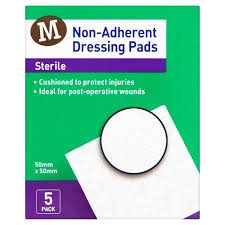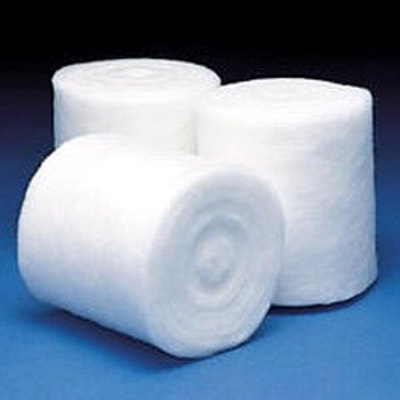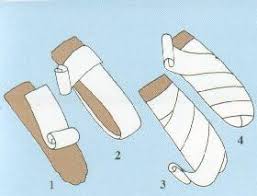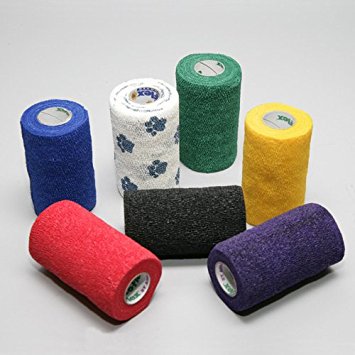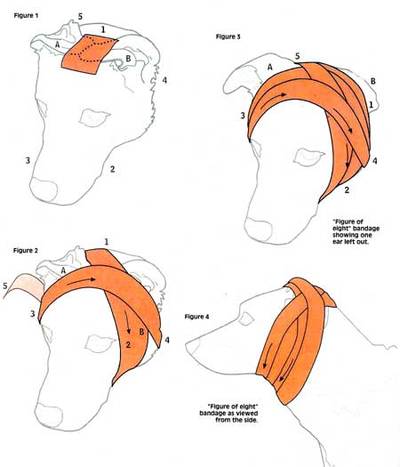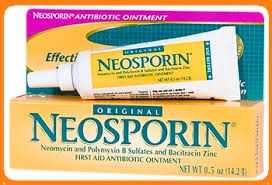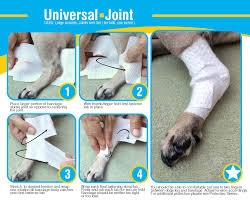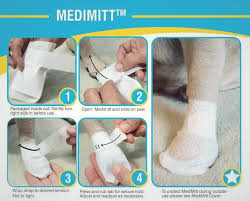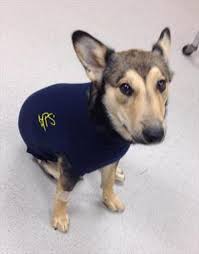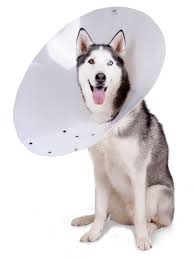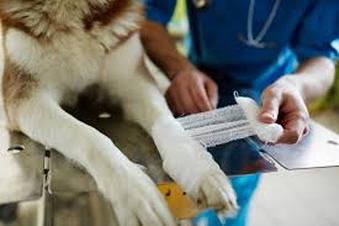
Bandaging & Wound Cleaning
Bandages are used for several reasons, to protect wounds from the environment, protect the environment from wounds, to discourage a dog from licking or irritating a wound. Bandages are also used as support against sprains and strains, or to even prevent motion. Therefore, proper application of a bandage is important, an improperly applied or tight bandage can cause decreased blood flow and potential loss of a limb.
Firstly you need to clean the wound from any debris, this could be dried blood, dirt etc, so make sure it’s washed away you can use a mild soap and lots of water or a safe dog friendly disinfectant. Any hair should be carefully clipped away so that it cannot lie in the wound, then if possible the wound should be patted dry.
Materials Required
In an ideal setting a bandage should have a contact layer, an absorbent layer and an outer layer.
Antibiotic ointment, Non-adherent pad, Cotton wrap, Gauze and Vetwrap.
The Contact Layer
After cleaning the wound, apply antibiotic ointment to the contact layer and use it first. Ideally, this layer should:
A Non Adherent Pad, available at most pharmacies, comes closest to meeting these requirements.
It is desirable to apply an antibiotic ointment, such as Neosporin, to the pad but this is not absolutely necessary. Frequent bandage changes are more important. After cleaning the wound, place a new contact layer over the wound.
The Absorbent Layer
After the contact layer is in place, apply the second (absorbent) layer to hold the contact layer snugly, but not tightly, over the wound. This layer is usually a cotton or Dacron material that comes in various widths. Generally, 1 inch rolls are used or small limbs and the tail, 2 inch rolls are for medium sized legs, and the 3 – 4 inch rolls for large legs and body. It is important to use the proper size. Materials that are too narrow they often cause a tourniquet effect, especially if the wound causes swelling.
If materials are too wide, they are difficult to apply smoothly. Any wrinkles or ridges may cause the bandage to become uncomfortable for your dog. Uneven pressure may cause necrosis (tissue death) of the underlying tissues.
Begin with just enough of an absorbent layer to hold the contact layer in place. If the wound is on a leg or the tail, wrap from the toes or the tip of the tail towards the body. If you begin at the top of the leg or tail, the bandage is more likely to restrict the blood flow and cause swelling, which may cause tissue damage. Apply several layers of absorbent material, which will soak up the fluid from the wound and increase the patients comfort by cushioning the wound.
Make sure the material you use as the absorbent layer is the proper width, and wrap from toes to tail tip up towards the body.
Gauze wrap can be applied next to hold the cotton wrap in place and to add extra support. This step can be skipped for small wounds or for temporary bandages.
The Outer Layer
Finally, apply the outer (third) layer, usually made up of porous adhesive tape or elastic tape (i.e. Elastikon, Vetwrap). Wrapped from the toes up towards the body, this layer should be smooth and snug. Do not stretch elastic tapes to their limits as this will interfere with circulation and result in bandage failure. It helps to unwrap the Vetrap or Elastikon first and then rewind it to remove the tension from the wrap before placing it.
The tape should be in contact with the skin (hair) at the bandage margins, anchoring the bandage so it will not slip.
The outer layer of the bandage should be applied smoothly and snugly, but not tight enough to cut off blood circulation.
Bandage Changes
Bandages should be checked frequently for any signs of swelling, skin discolouration or coolness, odour, or saturation of the bandage material. The bandage should be changed whenever any of the above are noticed or any time it appears to be uncomfortable for the dog. Wounds that are draining heavily may require bandage changes every 1 – 2 hours. Bandages over wounds with little or no drainage should be changed every 24 hours.
NB. Don't forget to use an Elizabethan Collar or Comfy Collar, and or Dog Surgical Suit, to stop your dog from biting his wound/bandages
Bandages are used for several reasons, to protect wounds from the environment, protect the environment from wounds, to discourage a dog from licking or irritating a wound. Bandages are also used as support against sprains and strains, or to even prevent motion. Therefore, proper application of a bandage is important, an improperly applied or tight bandage can cause decreased blood flow and potential loss of a limb.
Firstly you need to clean the wound from any debris, this could be dried blood, dirt etc, so make sure it’s washed away you can use a mild soap and lots of water or a safe dog friendly disinfectant. Any hair should be carefully clipped away so that it cannot lie in the wound, then if possible the wound should be patted dry.
Materials Required
In an ideal setting a bandage should have a contact layer, an absorbent layer and an outer layer.
Antibiotic ointment, Non-adherent pad, Cotton wrap, Gauze and Vetwrap.
The Contact Layer
After cleaning the wound, apply antibiotic ointment to the contact layer and use it first. Ideally, this layer should:
- Be sterile and inert.
- Stay in close contact with, but not stick to the wound.
- Be very absorbent.
- Be free of particles or fibres that might shed into the wound.
- Conform to all shapes.
- Allow drainage to pass to the next layer without becoming wet.
- Minimize pain.
A Non Adherent Pad, available at most pharmacies, comes closest to meeting these requirements.
It is desirable to apply an antibiotic ointment, such as Neosporin, to the pad but this is not absolutely necessary. Frequent bandage changes are more important. After cleaning the wound, place a new contact layer over the wound.
The Absorbent Layer
After the contact layer is in place, apply the second (absorbent) layer to hold the contact layer snugly, but not tightly, over the wound. This layer is usually a cotton or Dacron material that comes in various widths. Generally, 1 inch rolls are used or small limbs and the tail, 2 inch rolls are for medium sized legs, and the 3 – 4 inch rolls for large legs and body. It is important to use the proper size. Materials that are too narrow they often cause a tourniquet effect, especially if the wound causes swelling.
If materials are too wide, they are difficult to apply smoothly. Any wrinkles or ridges may cause the bandage to become uncomfortable for your dog. Uneven pressure may cause necrosis (tissue death) of the underlying tissues.
Begin with just enough of an absorbent layer to hold the contact layer in place. If the wound is on a leg or the tail, wrap from the toes or the tip of the tail towards the body. If you begin at the top of the leg or tail, the bandage is more likely to restrict the blood flow and cause swelling, which may cause tissue damage. Apply several layers of absorbent material, which will soak up the fluid from the wound and increase the patients comfort by cushioning the wound.
Make sure the material you use as the absorbent layer is the proper width, and wrap from toes to tail tip up towards the body.
Gauze wrap can be applied next to hold the cotton wrap in place and to add extra support. This step can be skipped for small wounds or for temporary bandages.
The Outer Layer
Finally, apply the outer (third) layer, usually made up of porous adhesive tape or elastic tape (i.e. Elastikon, Vetwrap). Wrapped from the toes up towards the body, this layer should be smooth and snug. Do not stretch elastic tapes to their limits as this will interfere with circulation and result in bandage failure. It helps to unwrap the Vetrap or Elastikon first and then rewind it to remove the tension from the wrap before placing it.
The tape should be in contact with the skin (hair) at the bandage margins, anchoring the bandage so it will not slip.
The outer layer of the bandage should be applied smoothly and snugly, but not tight enough to cut off blood circulation.
Bandage Changes
Bandages should be checked frequently for any signs of swelling, skin discolouration or coolness, odour, or saturation of the bandage material. The bandage should be changed whenever any of the above are noticed or any time it appears to be uncomfortable for the dog. Wounds that are draining heavily may require bandage changes every 1 – 2 hours. Bandages over wounds with little or no drainage should be changed every 24 hours.
NB. Don't forget to use an Elizabethan Collar or Comfy Collar, and or Dog Surgical Suit, to stop your dog from biting his wound/bandages

